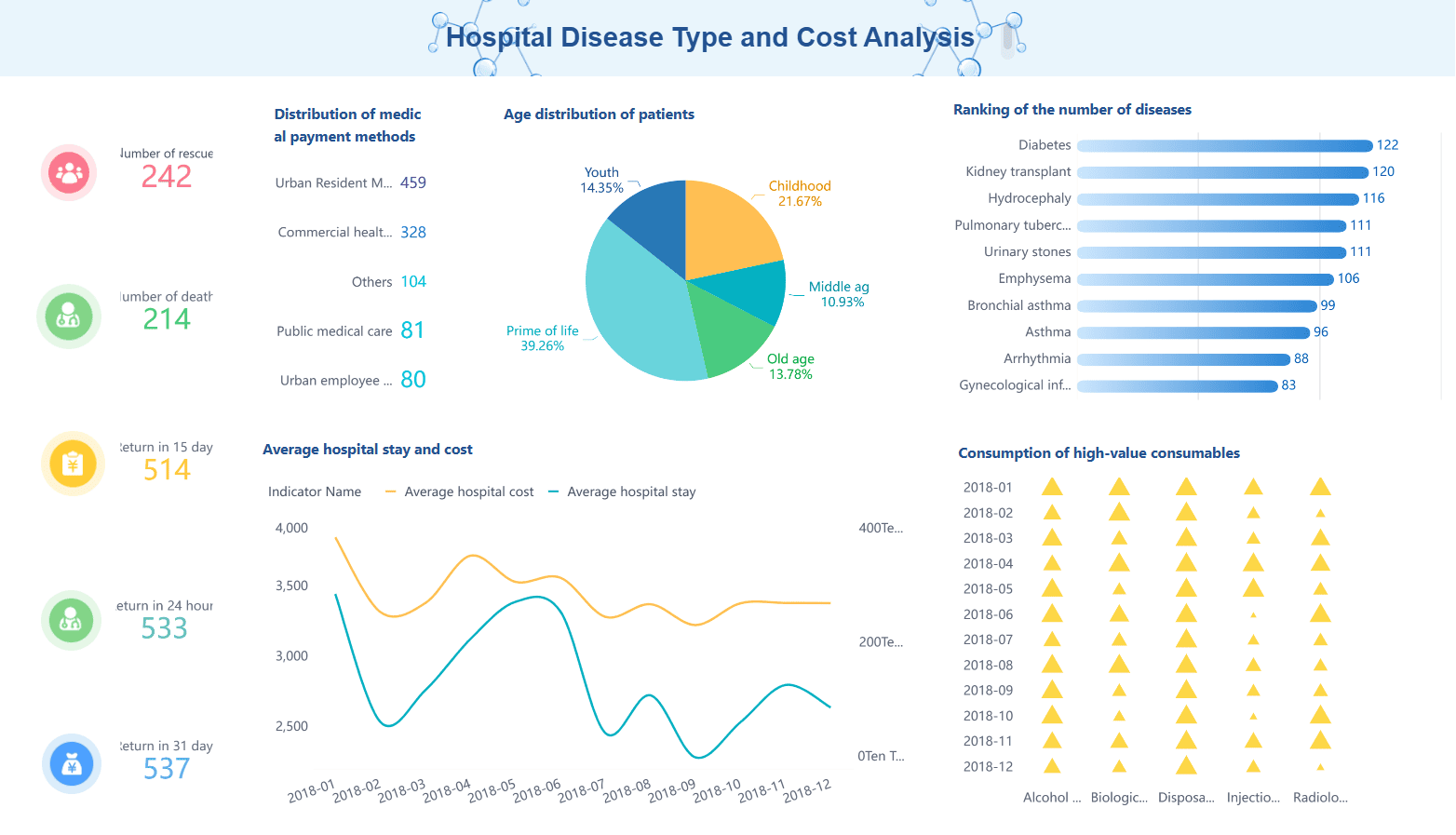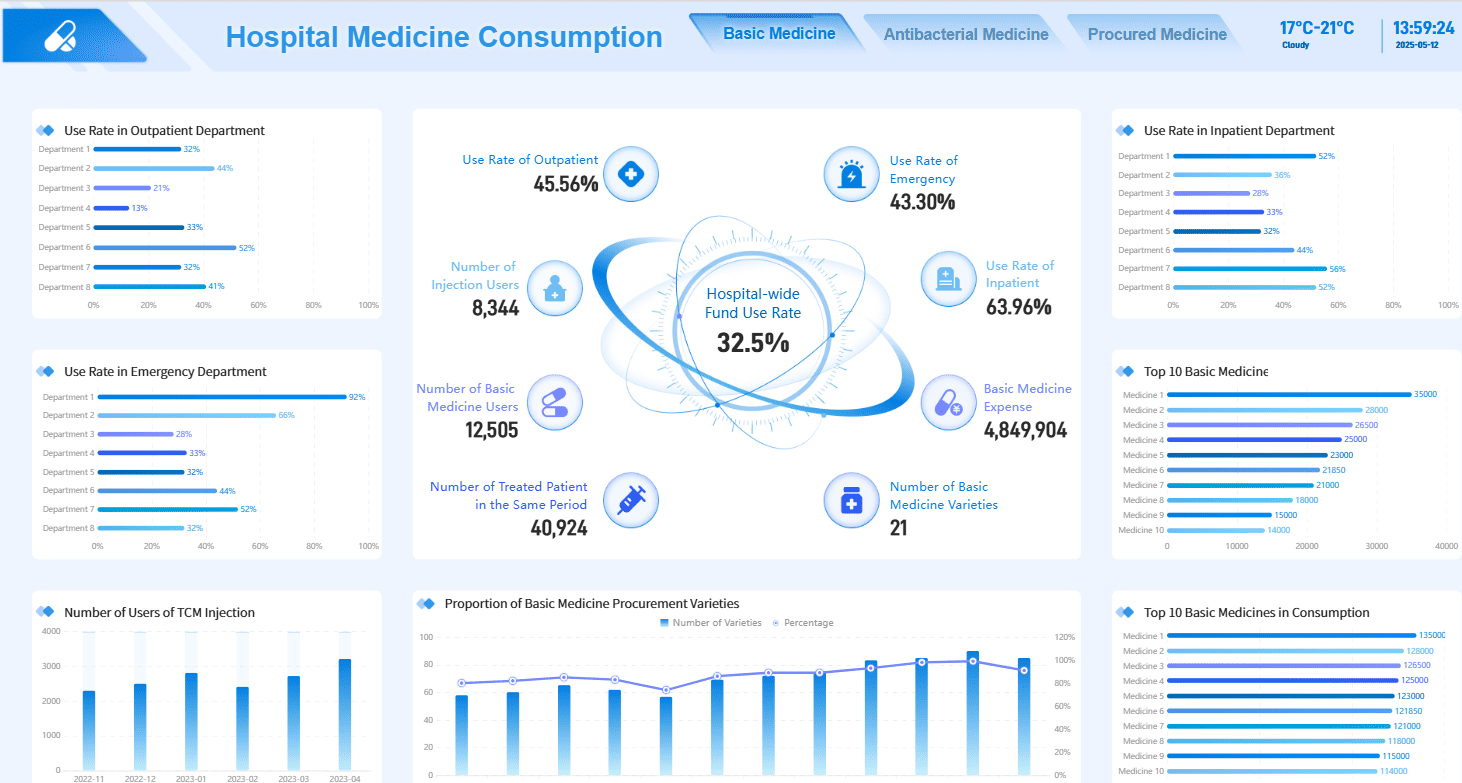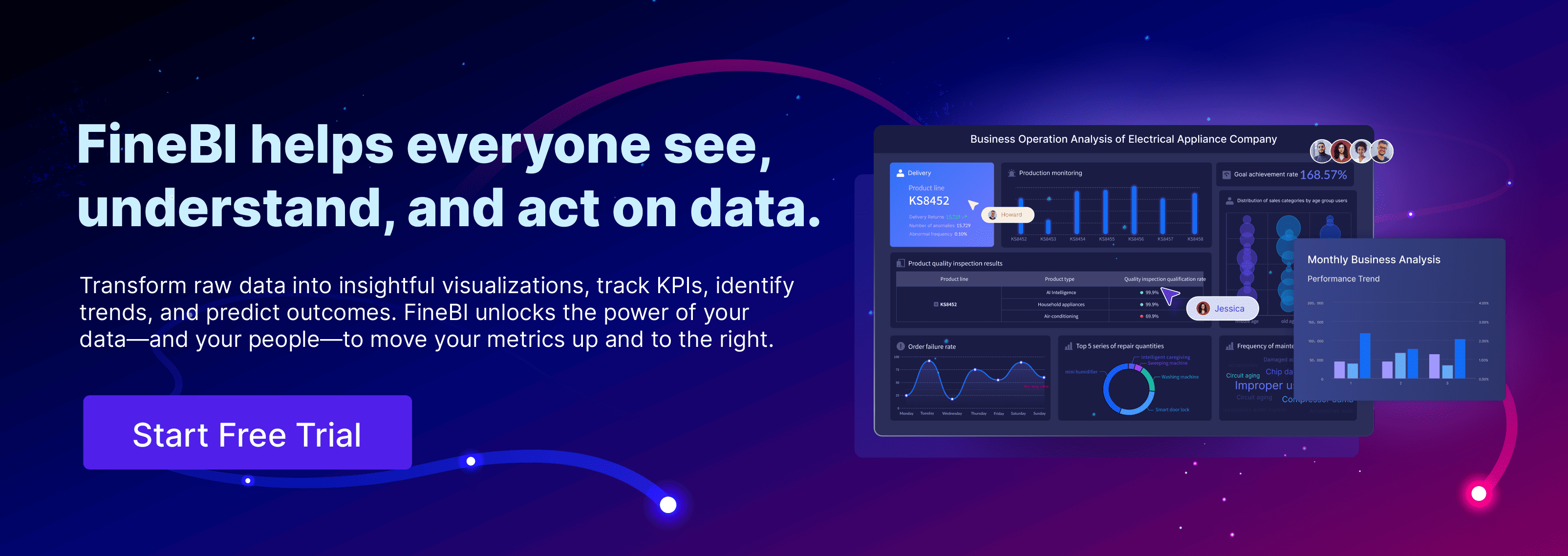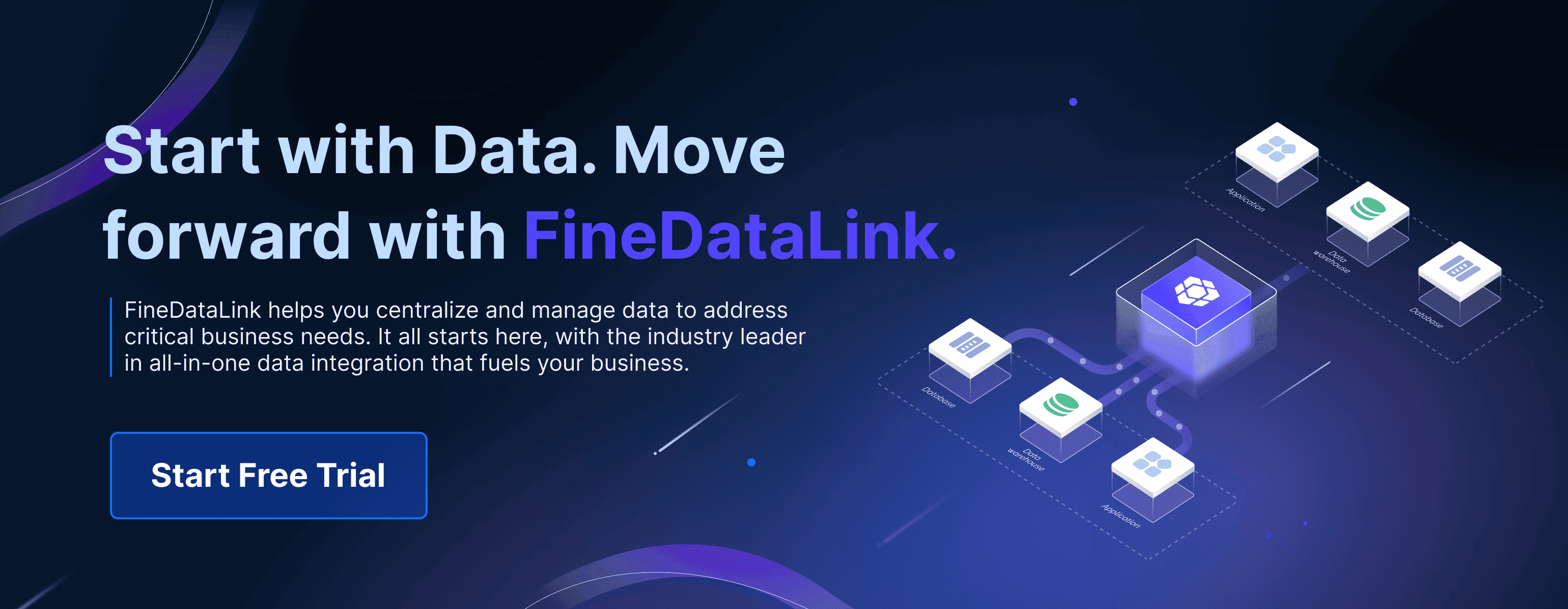The healthcare sector generates massive amounts of data every day. Business intelligence in healthcare plays a vital role in turning this data into actionable insights. You can see its impact in examples like Cleveland Clinic, where predictive analytics improves heart care by identifying risks after surgery. IBM Watson Health uses data to design personalized cancer treatments, while Kaiser Permanente enhances operational efficiency, cutting wait times and boosting patient satisfaction. These innovations show how data-driven insights reshape patient care and streamline operations. To stay competitive, healthcare organizations must adopt these tools to optimize resources and deliver better outcomes.
Every demo in this article was designed using FineBI. Ready to unlock smarter insights? Click below to start your free FineBI trial and see what’s possible!
The Business Intelligence in Healthcare
The rise of business intelligence in healthcare
You are witnessing a remarkable shift in healthcare as business intelligence becomes a cornerstone of modern medical practices. The adoption of cloud-based solutions has surged, with 47.5% of the market share in 2021 attributed to cloud delivery modes. This trend highlights how healthcare providers are leveraging cloud-based business intelligence tools to convert raw data into insightful dashboards. These tools enhance decision-making and improve operational efficiency.

For example, in March 2020, the Australian Department of Health launched the Coronavirus Australia App using Google Cloud. This app provided real-time COVID-19 updates and utilized business intelligence-enabled analytics to manage patient care and revenues effectively. Such advancements demonstrate how business intelligence is transforming healthcare into a more data-driven and efficient industry.
| Trend Description | Details |
|---|---|
| Cloud-based Solutions | 47.5% market share in 2021, showing significant cloud adoption in BI. |
| Data-Driven Decision-Making | BI tools convert data into actionable dashboards for better decisions. |
| Advancements in BI Software | SaaS applications enable real-time updates and enhance data security. |
How big data and analytics are revolutionizing patient care
Big data and analytics are reshaping patient care by enabling healthcare providers to make proactive and informed decisions. Hospitals generate 50 petabytes of data daily, and predictive analytics is helping transform this data into actionable insights. For instance, UCSF Health partnered with GE Healthcare to develop a predictive analytics model for ICU patients. By analyzing real-time data, this model helped anticipate patient deterioration, reducing ICU mortality rates and improving patient satisfaction.
Data analytics also plays a crucial role in drug discovery. It accelerates the process, reduces costs, and enables personalized medicine. By tailoring treatments to individual patient characteristics, healthcare providers can achieve better outcomes and greater efficiency. These innovations highlight how data analytics is revolutionizing patient care and driving the industry forward.
| Statistic Description | Value | Source |
|---|---|---|
| Daily data generated by hospitals | 50 petabytes | RootsAnalysis, 2024 |
| Fraud prevention savings using analytics | $210.7 million | Hewlett Packard Enterprise |
| Projected data growth rate | 36% CAGR by 2025 | Fingent, 2024 |
Why traditional methods fall short in modern healthcare
Traditional methods often fail to meet the demands of modern healthcare. Many rural and tribal populations still rely on traditional medicine due to limited access to quality healthcare. Approximately 65% of the population lives in rural areas, where healthcare facilities are scarce. This lack of infrastructure forces people to spend out-of-pocket on medical expenses, pushing 8% of the population below the poverty line.
High out-of-pocket costs and inadequate facilities highlight the inefficiencies of traditional approaches. Business intelligence in healthcare offers a solution by addressing these gaps. By integrating data from various sources, BI tools provide actionable insights that improve resource allocation and enhance patient care. These tools empower healthcare providers to overcome the limitations of traditional methods and deliver better outcomes.
Note: Traditional methods cannot keep up with the growing complexity of healthcare. Business intelligence bridges this gap by offering data-driven solutions that improve accessibility and efficiency.
Key benefits of business intelligence in healthcare
Enhancing decision-making with actionable insights
Business intelligence empowers you to make informed decisions by transforming raw data into actionable insights. In healthcare, this capability is invaluable. For example, hospitals can use BI tools to analyze patient admission trends and predict future demand. This ensures that resources, such as staff and equipment, are allocated efficiently.
Key performance indicators (KPIs) play a crucial role in this process. Metrics like operational throughput, resource utilization, and logistics efficiency help you identify bottlenecks and streamline workflows. For instance, Walmart analyzes 10 million daily transactions to optimize inventory and operations. Similarly, healthcare organizations can leverage BI to refine their processes and improve decision-making.
| Metric Type | Examples of KPIs | Purpose |
|---|---|---|
| Business Efficiency KPIs | Operational throughput, resource utilization, logistics efficiency | Identify bottlenecks and inefficiencies in workflows. |
| Profitability KPIs | Gross profit margins, cost-to-serve, product-level profitability | Determine the most and least profitable areas of the business for strategic prioritization. |
BI systems also enhance decision-making by providing real-time insights. For example, SKF transitioned to BI dashboards, achieving 40% faster processes and 20% lower staff costs. In healthcare, this translates to quicker responses to patient needs, ultimately improving the patient experience.
Tip: By adopting business intelligence, you can shift from reactive to proactive decision-making, ensuring better outcomes for both patients and healthcare providers.
Improving operational efficiency and reducing costs
Operational efficiency is a cornerstone of value-based care. Business intelligence helps you achieve this by optimizing resource allocation and uncovering cost-saving opportunities. For example, BI tools analyze usage data for medical supplies, equipment, and staffing. This ensures that resources are neither overused nor underutilized.
Healthcare organizations have reported significant improvements in efficiency through BI. Clinics align staff schedules with patient needs, minimizing downtime and enhancing patient care. Hospitals also use BI to optimize financial management, reducing operational costs without compromising care quality.
- Increased Efficiency: Better alignment of staff schedules with patient needs improves patient care and minimizes downtime.
- Cost Savings: Optimized resource utilization leads to reduced operational costs and improved overall efficiency.
- Data-Driven Decisions: BI tools provide the data you need to make evidence-based decisions, enhancing care quality and patient satisfaction.
For example, predictive analytics can identify trends in patient admissions, enabling hospitals to prepare in advance. This not only reduces wait times but also ensures that critical resources are available when needed. By improving operational efficiency, you can deliver value-based care while achieving cost reduction.
Boosting patient outcomes through personalized care
Personalized care is at the heart of improved patient outcomes. Business intelligence enables you to tailor treatments based on individual patient data, such as medical history, genetic information, and lifestyle factors. This approach enhances patient care by addressing specific needs rather than relying on generalized treatments.
Predictive analytics plays a key role in this process. By identifying at-risk patients early, you can implement proactive interventions. For example, predictive models help healthcare providers identify patients at high risk for readmission. Targeted follow-up care reduces readmission rates and associated costs, improving the overall patient experience.
- Tailored Treatment Plans: Data from wearables and electronic health records (EHRs) allows you to create personalized treatment plans. This improves chronic disease management and enhances patient outcomes.
- Proactive Interventions: Early identification of at-risk patients enables timely interventions, reducing complications and improving recovery rates.
- Better Healthcare Outcomes: Advanced analytics integration leads to more effective treatments and better long-term results.
Personalized medicine also supports value-based care by focusing on outcomes rather than procedures. By leveraging BI tools, you can enhance patient care and ensure that every decision contributes to improved patient outcomes.
Note: Personalized care not only improves patient satisfaction but also strengthens the trust between patients and healthcare providers.
Supporting compliance and regulatory reporting
Compliance with healthcare regulations is a critical responsibility for healthcare organizations. Business intelligence tools simplify this process by providing a centralized platform to store, analyze, and monitor patient data. These tools ensure that your organization adheres to healthcare standards while reducing the risk of penalties. For example, they track adherence to regulations like HIPAA (Health Insurance Portability and Accountability Act) by identifying anomalies in patient data that could lead to compliance issues.
Maintaining accurate records is another essential aspect of regulatory compliance. Business intelligence in healthcare enables you to automate record-keeping processes, ensuring that all data is up-to-date and error-free. This automation minimizes manual errors, which are often the root cause of compliance violations. By using BI dashboards, you can also generate real-time reports that provide a clear view of your organization's compliance status. These reports make it easier to prepare for audits and demonstrate adherence to regulatory requirements.
Several healthcare organizations have successfully leveraged business intelligence to enhance compliance efforts. For instance:
- Cleveland Clinic implemented a BI strategy using Tableau to integrate data for real-time insights into patient outcomes and resource utilization. This approach not only improved operational efficiency but also ensured compliance with healthcare standards.
- Kaiser Permanente utilized Power BI to create a unified view of patient data. This streamlined care coordination and reduced readmission rates, demonstrating how BI tools can support both compliance and better patient care.
Business intelligence also plays a vital role in managing operational efficiency while meeting regulatory demands. By analyzing data trends, you can identify areas where processes need improvement. For example, BI tools can highlight inefficiencies in billing systems, ensuring that claims are processed accurately and in compliance with payer requirements. This reduces the likelihood of claim denials and financial penalties.
Tip: Use BI tools to set up automated alerts for compliance-related metrics. These alerts notify you of potential issues before they escalate, allowing you to take corrective action promptly.
In today’s complex regulatory environment, relying on manual methods for compliance is no longer sufficient. Business intelligence empowers you to stay ahead by providing the tools needed to manage compliance efficiently and effectively. By integrating BI into your operations, you can focus on delivering high-quality care while ensuring that your organization meets all regulatory requirements.
Use cases of business intelligence in healthcare
Identifying growth opportunities with FineBI
Market analysis and service expansion
Business intelligence tools like FineBI empower you to identify growth opportunities by analyzing market trends and patient demographics. These tools consolidate data from various sources, providing a comprehensive view of your healthcare market. For example, FineBI enables you to assess patient needs in underserved areas, helping you expand services strategically. By understanding which services are in demand, you can allocate resources effectively and improve operational efficiency.
FineBI also supports competitive analysis. You can evaluate your competitors' performance and identify gaps in their offerings. This insight allows you to position your services uniquely, attracting more patients and increasing market share. With FineBI, you can make data-driven decisions that align with your organization's growth objectives. Here is an interactive demo created by FineBI, click to experience it.
Predicting patient demand and resource allocation
Predicting patient demand is critical for optimizing resource allocation. FineBI uses advanced data analytics to forecast patient volumes based on historical data and current trends. This helps you prepare for fluctuations in demand, ensuring that staff, equipment, and facilities are available when needed.
For instance, during flu season, predictive analytics can estimate the number of patients likely to visit your facility. You can then adjust staffing levels and stock up on necessary supplies. This proactive approach minimizes wait times and enhances patient care. FineBI's ability to predict demand ensures that you can allocate resources efficiently, reducing costs and improving patient satisfaction.
| Use Case | Description |
|---|---|
| Healthcare Data Management | Centralized data aggregators streamline data handling, improving patient outcomes and operational efficiency. |
| Patient Flow Management | BI tools optimize scheduling and resource allocation, ensuring timely care and increasing patient satisfaction. |
| Resource Management | Forecasting demand helps hospitals allocate staff, equipment, and supplies effectively. |
| Discharge Process | BI identifies bottlenecks, improving the efficiency of patient discharges and freeing up beds. |
| Bed Management | Tracking bed occupancy with BI tools anticipates demand and ensures availability of hospital beds. |

Streamlining revenue cycle management
Reducing billing errors and improving collections
Revenue cycle management is a critical aspect of healthcare operations. Business intelligence tools help you reduce billing errors by automating data entry and validation processes. This ensures that claims are accurate and compliant with payer requirements. By minimizing errors, you can avoid claim denials and accelerate reimbursements.
BI tools also enhance collections by identifying outstanding payments and prioritizing follow-ups. For example, FineBI provides dashboards that highlight overdue accounts, enabling your team to focus on high-priority cases. This targeted approach improves cash flow and reduces the administrative burden on your staff.
Optimizing financial performance with predictive analytics
Predictive analytics plays a vital role in optimizing financial performance. By analyzing historical revenue data, BI tools can identify trends and forecast future income. This insight helps you set realistic financial goals and allocate resources effectively.
Organizations that adopt a data-driven approach to revenue cycle management report significant improvements. Over 87% of C-suite executives recognize the importance of accessible business analytics. Enterprises using these tools experience an average annual growth of over 30%. FineBI's predictive capabilities enable you to make informed financial decisions, ensuring long-term sustainability.
- Data-driven strategies replace intuition, leading to more accurate financial planning.
- Analytics identify inefficiencies in billing and collections, improving revenue growth.
- Organizations using BI tools report higher operational efficiency and profitability.
Enhancing patient care and outcomes with FineReport
Leveraging patient data for personalized treatment plans
FineReport enables you to leverage patient data to create personalized treatment plans. By integrating data from electronic health records (EHRs), wearables, and other sources, FineReport provides a holistic view of each patient. This allows you to tailor treatments based on individual needs, improving patient outcomes.
For example, FineReport can analyze a patient's medical history and lifestyle factors to recommend specific interventions. This personalized approach enhances chronic disease management and reduces the risk of complications. By focusing on individual needs, you can deliver more effective care and build stronger patient relationships.
Monitoring population health trends
Monitoring population health trends is essential for proactive healthcare management. FineReport helps you analyze data from multiple sources to identify patterns and trends in public health. This insight enables you to address emerging health issues before they escalate.
For instance, FineReport can track the spread of infectious diseases, helping you allocate resources to high-risk areas. It also supports health promotion initiatives by identifying populations at risk for chronic conditions. By using FineReport to monitor health trends, you can improve community health outcomes and reduce healthcare costs.
Tip: Use healthcare business intelligence tools like FineBI and FineReport to enhance both individual patient care and population health management. These tools provide the insights you need to make informed decisions and seize growth opportunities.
Optimizing supply chain management
Ensuring the availability of critical medical supplies
Healthcare facilities rely on timely access to critical medical supplies to ensure uninterrupted patient care. Business intelligence tools play a pivotal role in achieving this by providing real-time visibility into inventory levels. These tools analyze historical data and external factors, enabling you to forecast demand accurately. For example, during flu season, predictive analytics can help you anticipate the need for vaccines and antiviral medications. This ensures that essential supplies are available when patients need them most.
AI-driven inventory management systems further enhance supply chain efficiency. They monitor stock levels continuously, alerting you to potential shortages before they occur. This proactive approach reduces the risk of stockouts, which can compromise patient care. Additionally, these systems streamline procurement processes, ensuring that supplies are ordered and delivered promptly.
Several healthcare organizations have successfully implemented these strategies. The Mayo Clinic reduced inventory costs by leveraging AI for demand forecasting. Cleveland Clinic optimized procurement processes, minimizing waste and ensuring the availability of critical supplies. CVS Health improved supply chain visibility across multiple locations, enhancing inventory management and patient care outcomes.
Tip: Use business intelligence tools to monitor inventory in real time. This ensures that critical supplies are always available, reducing disruptions in patient care.
Reducing waste and managing inventory effectively
Waste in healthcare supply chains is a significant challenge, with nearly 30% of hospital supply chain spending going to waste. Business intelligence tools address this issue by optimizing inventory management. AI technologies analyze historical usage patterns and external factors, helping you predict inventory needs accurately. This reduces the likelihood of overstocking or understocking, minimizing waste from expired items.
Real-time inventory tracking is another key benefit. These systems provide continuous updates on stock levels, allowing you to identify surplus items and redistribute them to areas of need. This reduces waste and ensures efficient use of resources. For example, AI-driven systems can flag supplies nearing expiration, enabling you to use them before they become unusable.
The potential for waste reduction is substantial. AI technologies can cut supply chain waste by up to 50%, saving healthcare facilities millions of dollars annually. By adopting these tools, you can improve operational efficiency and allocate resources more effectively.
| Evidence Type | Description |
|---|---|
| Waste Percentage | Nearly 30% of hospital supply chain spending goes to waste. |
| Waste Reduction Potential | AI can help reduce supply chain waste by up to 50%. |
Healthcare organizations like Cleveland Clinic and Mayo Clinic have demonstrated the effectiveness of these strategies. By using AI-driven inventory management systems, they minimized waste and improved procurement processes. These examples highlight how business intelligence tools can transform supply chain management, ensuring both cost savings and better patient care outcomes.
Note: Reducing waste not only saves money but also contributes to sustainable healthcare practices. Business intelligence tools empower you to manage inventory efficiently, ensuring that resources are used wisely.
Challenges in implementing business intelligence in Healthcare
Data integration and interoperability issues
Implementing business intelligence tools in healthcare often faces challenges related to data integration and interoperability. You encounter these issues when trying to consolidate data from multiple sources, such as electronic medical records (EMRs), wearable devices, and lab systems.
- Lack of standardization in data formats creates silos, making it difficult to share information across platforms.
- Security and compliance concerns arise due to regulations like HIPAA. Healthcare organizations face an average of 1,410 cyberattacks per week, highlighting the risks involved.
- Technical limitations, such as reliance on on-premises data storage, restrict scalability and hinder integration with external systems.
Inconsistent data formats across EMR systems further complicate interoperability. Vendor lock-in also limits your ability to adopt newer software solutions, preventing process improvements. Organizational barriers, including resistance to change and insufficient training, slow digital advancements.
Tip: To overcome these challenges, prioritize solutions that support standardized data formats and offer robust integration capabilities.
Ensuring data security and patient privacy
Data security and patient privacy are critical concerns when implementing business intelligence tools. You must safeguard sensitive information while complying with strict regulations. However, breaches remain a significant issue in healthcare.
- Human error accounts for 43% of healthcare data breaches, emphasizing the need for employee training.
- Malicious attacks, such as phishing and ransomware, cause 36% of breaches.
- Technical failures contribute to 21% of breaches, underscoring the importance of system maintenance.
The financial impact of these breaches is staggering. The average cost of a healthcare data breach is $10.93 million, the highest among all industries. In the U.S., the average cost per breach reaches $9.48 million. Breaches in healthcare often go undetected for 213 days, longer than the average of 194 days in other sectors.
Note: Regular employee training and robust cybersecurity measures can significantly reduce the risk of breaches.
Overcoming resistance to change within organizations
Resistance to change is a common obstacle when introducing business intelligence tools. You may face pushback from staff who are accustomed to traditional methods. This resistance often stems from a lack of understanding about the benefits of BI tools.
Organizational barriers include inadequate investment in training and resources. Without proper education, employees struggle to adapt to new systems. Additionally, some staff may fear that automation will replace their roles, leading to reluctance in adopting BI solutions.
To address these challenges, focus on fostering a data-driven culture. Provide clear communication about the advantages of BI tools, such as improved efficiency and better patient outcomes. Offer hands-on training sessions to build confidence and ensure smooth transitions.
Tip: Engage employees early in the implementation process to create a sense of ownership and reduce resistance.
Solutions for successful implementation of Business Intelligence in Healthcare
Leveraging FanRuan’s FineDataLink for seamless data integration
Data integration is a cornerstone of successful implementation of business intelligence in healthcare. You often deal with data from multiple sources, such as electronic health records (EHRs), wearable devices, and lab systems. FanRuan’s FineDataLink simplifies this process by consolidating data into a unified platform. This tool supports over 100 data sources, allowing you to integrate and synchronize data in real time. Its visual interface makes it user-friendly, even for those with limited technical expertise.

FineDataLink also enhances data quality through automated cleansing and transformation. This ensures that the insights you derive are accurate and actionable. For example, you can use FineDataLink to synchronize patient data across departments, reducing duplication and errors. This streamlined approach not only saves time but also improves decision-making. By leveraging FineDataLink, you can build a robust data foundation for tools of business intelligence in healthcare.
Tip: Use FineDataLink to create a real-time data warehouse. This enables you to access up-to-date information for faster and more informed decisions.
Training staff and fostering a data-driven culture
A data-driven culture is essential for maximizing the benefits of tools of business intelligence in healthcare. Training your staff ensures they understand how to use these tools effectively. This education empowers them to make data-supported decisions, enhancing both operational efficiency and patient care.
Training programs yield significant benefits, including:
- Enhanced decision-making, leading to increased revenue and improved customer service.
- Attraction and retention of top talent, as employees value organizations committed to data-driven practices.
- Greater transparency and accountability in decision-making, supporting compliance.
- Actionable market insights that reduce speculation and ambiguity.
- Cost savings from data-supported decisions, improving operational efficiency.
By fostering a data-driven culture, you create an environment where every team member contributes to better outcomes. This approach not only improves patient care but also strengthens your organization’s competitive edge.
Note: Regular training sessions and workshops can help your staff stay updated on the latest features of your business intelligence in healthcare.
Partnering with experienced BI vendors for tailored solutions
Collaborating with experienced business intelligence vendors ensures you receive solutions tailored to your specific needs. These vendors bring expertise and industry knowledge, helping you overcome challenges like data integration and compliance.
For example, Cleveland Clinic partnered with a BI vendor to enhance hospital operations. They implemented a Virtual Command Center to manage resources, streamline wait times, and track bed availability. Similarly, Mayo Clinic used a unified database to identify and treat rare diseases. This collaboration enabled personalized treatment plans and improved patient outcomes.
| Organization | Benefits of BI Partnership | Key Applications |
|---|---|---|
| Cleveland Clinic | Enhanced hospital operations, improved outcomes in genomics and population health | Virtual Command Center for resource management, wait time streamlining, bed availability tracking |
| Mayo Clinic | Identification and treatment of rare diseases, personalized treatment plans | Unified Optum Labs database for data sharing and clinician consultation with other clinics |
Partnering with the right vendor ensures you have access to cutting-edge tools and support. This collaboration allows you to focus on delivering high-quality care while the vendor handles technical complexities.
Tip: Choose a vendor with a proven track record in healthcare. Their expertise can help you implement solutions that align with your goals.
Business intelligence in healthcare has revolutionized the industry by enhancing patient outcomes, reducing costs, and enabling real-time decision-making. Tools like FineBI and FineReport empower you to identify inefficiencies, optimize operations, and deliver personalized care. For example, BI solutions help healthcare organizations proactively address patient risks and streamline workflows, ensuring better service delivery. The table below highlights the key performance indicators that showcase the transformative potential of these tools:
| Key Performance Indicator | Description |
|---|---|
| Improved Patient Outcomes | Business intelligence in healthcare help identify patients at risk, enabling proactive interventions. |
| Cost Reduction | BI solutions streamline operations, leading to reduced costs in healthcare delivery. |
| Real-time Decision Making | A strong BI strategy allows for data-driven decisions, enhancing the accuracy of healthcare operations. |
| Operational Efficiency | Identifying inefficiencies in workflows helps optimize operations and improve service delivery. |
| Competitive Advantage | Leveraging BI provides insights that help healthcare businesses stay ahead of competitors. |
Adopting these tools equips you to stay competitive and deliver exceptional care. Take the first step toward a data-driven future today.
Click the banner below to try FineBI and FineReport for free and empower your enterprise to transform data into productivity!
Continue Reading About Business Intelligence in Healthcare
Why Healthcare Data Analysis Is Critical in 2025: Turning Data into Better Outcomes
FAQ

The Author
Lewis
Senior Data Analyst at FanRuan
Related Articles

What Are Enterprise BI Solutions and How Do They Work
Enterprise BI solutions unify business data, enabling real-time analytics, secure collaboration, and smarter decision-making across your organization.
Lewis
Dec 22, 2025

What is a BI Dashboard and Why Does Your Business Need One
A BI dashboard centralizes business data, tracks KPIs, and delivers real-time insights, empowering smarter decisions and boosting business performance.
Lewis
Dec 19, 2025

Power BI vs Tableau Which Analytics Platform Wins
Power BI vs Tableau: Compare features, pricing, and integration to see which analytics platform best fits your business and data visualization needs.
Lewis
Dec 19, 2025






